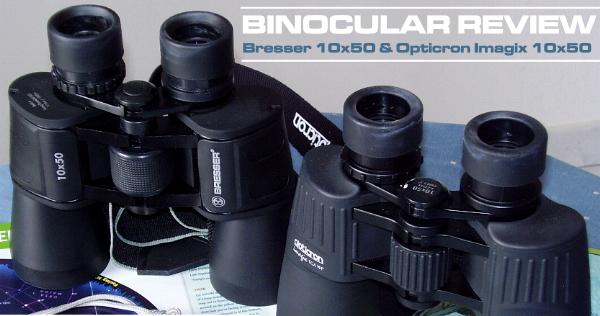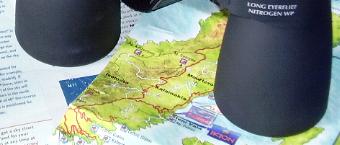 |
On a recent holiday abroad I took my two pairs of 10x50 binoculars
with me. 10x50 is an ideal size for astronomy being light enough to hand hold
and not so powerful that you require a tripod.
The perfectly dark skies of a small Greek island gave me
the opportunity to put the two pairs to work against flawless skies and to
allow them to be compared......... |
|
 |
|
The
two pairs of binoculars are far apart in the price spectrum so this review may
give newcomers to the hobby an idea of what to expect and whether its worth
splashing out on quality gear.
Bresser 10 x
50
These are regularly sold
in Lidls at bargain prices. They tend to be on sale two or three times a year.
Mine cost £14.99. The binoculars are supplied in a soft nylon case
together with the lens caps, neck strap, cleaning cloth and a surprisingly good
colour manual. The overall quality and feel is fine considering the price.
The binoculars are mostly covered in a
soft rubber coating and feature twist up eyecups. Lens coatings appear to be on
the objective lens only and the coating appears from looking at it to be very
thin. They feature independent focusing for the right eye to allow for any
differences in the quality of your eyesight.
The binoculars also feature a twist off cap which gives
you access to a mounting lug for attaching the binoculars to a tripod. The
plastic cap itself is easily damaged as it is simply compression fitted over
the lug.
The overall feel of the
binoculars is quite good; the focus wheel on my pair was good when new but over
time has become slightly looser and exhibits small degrees of slop in the
mechanism caused by backlash of the focuser gearing. The overall mechanical fit
and finish is neither terrible nor excellent - adequate is how I would describe
it. The binoculars are quite light and comfortable with the soft rubber
coatings and a dimpled area where your hands fall providing a good grip. Eye
relief is quite generous at around 19mm and generally the binoculars are
comfortable to use. The twist up eye cups are quite stiff but work well enough.
The view with the Bressers shows a fair amount of false colour and
fringing together with a slightly soft focus. Views of deep sky objects such as
the Andromeda Galaxy show a loss of definition. Overall contrast though is
quite good. Generally speaking the views are pleasing.
Views of the moon show a yellowish tinge which is also
evident with daylight viewing suggesting the lens coatings or optical elements
may be not well tuned. None of these factors were out of control or even close
to rendering the binoculars unusable as general purpose binoculars and indeed
many of the views such as the double cluster in Perseus, Kembles Cascade and
the Hercules cluster were very good along with the views of the moon despite
the yellowish tinge added to it by the optics.
The false colour, while present, never hurts the views to any
significant degree.
Viewing terrestrial
targets yields quite good views. The focusing isn't quite as precise as on
higher quality models but acceptable none the less.
Verdict
Perfectly usable binoculars for a range of viewing including
terrestrial and astronomical for those on a tight budget.
Although the Bressers are outperformed by the other pair being
reviewed you have to bear in mind price. For the money, which is less than
you'd pay for a toy telescope, the Bressers showed an amazingly good
performance that would even rival some more expensive binoculars. Indeed if
these were the only binoculars you used you would scarcely notice some of the
aberrations - its only in direct comparison with significantly more expensive
binoculars that some of these faults will be apparent to any but an experienced
observer.
|
If you buy these Bresser
binoculars from Lidl you should buy carefully. The quality of these binoculars
varies to some extent. Here's my tips for selecting a pair. Don't be afraid to
open the box and check them.
Focus - The focus wheel in the centre of the binoculars should
move well. It should ne neither too tight nor too loose. Check the wheel feels
'slick'.
Now wind the focus wheel until the eyepieces are furthest from the
binocular body and while holding the body try to gently push the eyepieces back
towards the body with your thumbs. There should be no movement.
Flex - Binoculars flex along their central pin to set the
distance between the eyepieces for your eyes. Try flexing the binoculars back
and forth a few times. The movement should stay quite stiff. If its loose
reject them and try another pair.
Optics - Look down the objective lens (the
big one at the front) of both sides at about arms length distance. You should
see no obstructions and the view should show a perfect circle with no obvious
flat surfaces.
Overall - Check the fit and finish, adjust the binoculars for
your eyes and take a look at something in the distance. How does the view look
? Does it come to focus ? If you cant focus or the binoculars show a tendency
to create a kind of double vision/boss eyed feeling then reject them and try
another pair.
Warranty - The Bressers are supplied with a 5 year return to
base warranty so if you should have problems don't be afraid to either go back
to Lidls or take any issues up with Bresser. |
Opticron Imagic TGA WP 10x50
These were bought on a personal recommendation. I was
seeking a good quality pair of general use binoculars whose principle use would
be astronomy. The Opticron Imagics were priced at £130 from First Light
Optics.
The Opticron Imagics were
supplied in a quality soft leather look case along with a neck strap, dust caps
a cleaning cloth and simple instruction manual which was clear and easy to
understand.
The overall feeling when handled is that this is quality
equipment. The binoculars are completely coated in a high quality rubber armour
and are nitrogen purged to make them both waterproof and more resistant to
dewing. They have soft rubber eyecups that twist up and provide very
comfortable viewing. The lenses are multi-coated and show a deep lustrous coat.
The focus wheel is smooth and sure and the binoculars come to focus very easily
and precisely. Eye relief is good at a stated 19.5mm and the binoculars are
supremely comfortable to view with as well as being very tactile. There is a is
a small screw on/off plastic cap covering a lug to allow the fitting of the
binoculars to a tripod.
The view through the Opticron
Imagics is quite simply superb. My previous binoculars were high quality Zeiss
Marines but the Opticron Imagics offer a far better view as well as being more
comfortable.
The view is sharp, crisp,
very bright and about as lacking in false colour as its possible to expect from
any binocular product. Edges of distant objects are razor sharp and contrast is
sharp and well defined. Using the binoculars for astronomy and prolonged
periods reinforces the quality of the views and the comfort of the binoculars.
My eyes can be strained relatively easy
but I find the Opticron Imagics very easy to use for very prolonged periods.
The Andromeda Galaxy revealed very good detail and viewing the moon through
them is astounding. The detail revealed would easily rival or exceed many small
telescopes. Views of the Orion Nebula showed traces of nebulosity very well and
star fields and open clusters are perfectly resolved with stars resolving to
single points of light in most cases. The view was always well contrasted and
controlled.
Terrestrial targets are also well defined and these binoculars
provide a huge amount of performance.
Verdict
Easily the best binoculars I have owned
and a joy to be in possession of. They are comfortable with good eye relief.
They feel perfect in the hands and are relatively light for their size. The
quality of these cannot be faulted with everything working perfectly - even the
twist up eye cups have a silky smooth but positive feel, focusing is precsion
itself with no noticeable backlash. The optics offer up crystal clear views.
Using them on astronomical targets yields a unique quasi 3D aspect to the image
which is quite addictive I found.
Overall Verdict
So how do the views compare ? Well you
wont be surprised to know the Opticron Imagic pair provide better views, the
view has a higher contrast, less false colour, sharper focusing and for
astronomical use are superb. They also have a more quality feel to them.
Where the quality between the two pairs
really showed was the views of Jupiter. The Bressers showed Jupiters moons but
not well - the Opticrons show the moons far better. The other target which
really showed the difference was the Andromeda Galaxy. The Bressers would show
it but to nowhere near the brightness and contrast of the view offered by the
Opticrons.
The Bressers have rather imprecise and vague focusing
and lack the optical sharpness but they do have a huge redeeming feature which
is they are extremely cheap. The views through the Bresser binoculars were
probably adequate for a beginner and far better than any telescope of a similar
price could deliver. The fact that they don't perform as well as a product
which cost 10x their price is not really surprising. For the price the Bressers
are unbeatable especially if your looking for your first entrée into
binocular astronomy or working to a shoestring budget.
If you are tempted by the Bressers as cheap introduction
to astronomy then you should check through the pile for a good pair when they
appear in Lidl (see the tips sections above).
If your considering buying
quality binoculars for the best views then I don't think the Opticron Imagics
would disappoint anyone. They are quality through and through, beautifully
made, precise and offering great views. I'd recommend them to
anyone.
Check out First Light Optics below for friendly and expert advice on
good quality binoculars. |
 |
|
|